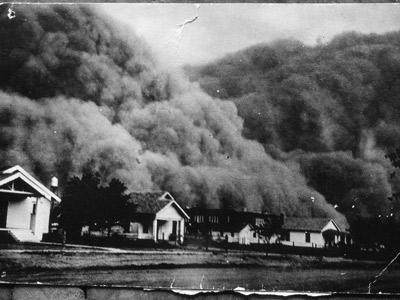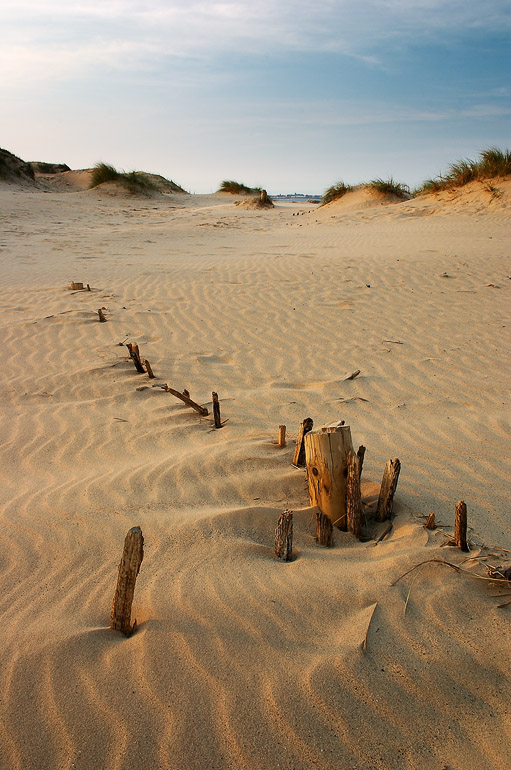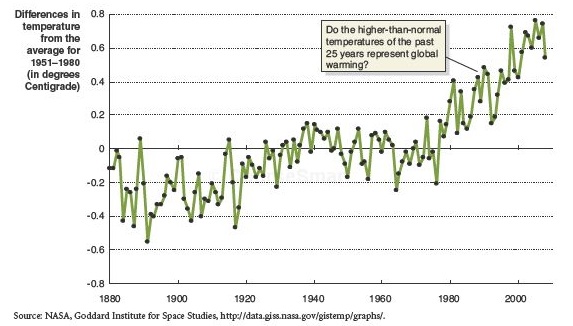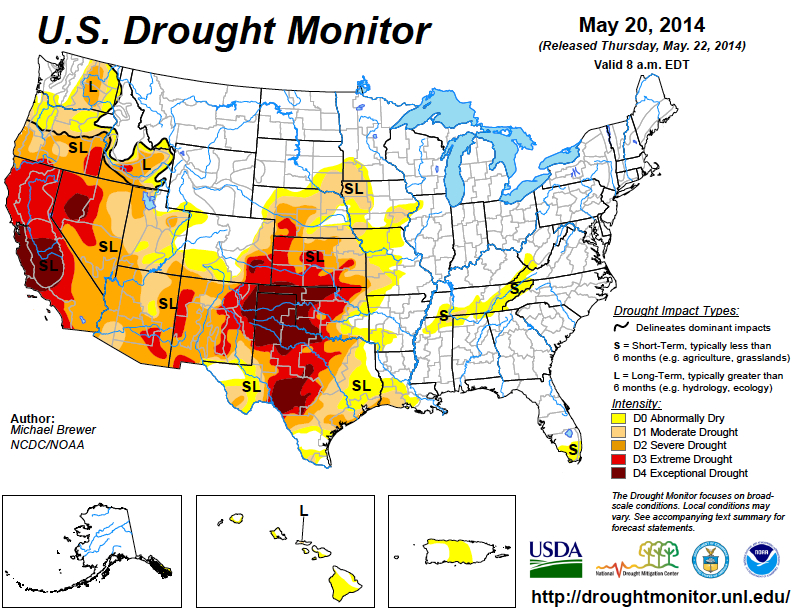"that men will fail themselves."


Farm Security Administration c., 1935, Kansas farmstead in the dust bowl.
Duster on "Black Sunday," 1935.
"...Houses were shut tight, and cloth wedged around doors and windows, but the dust came in so thinly that it could not be seen in the air, and it settled like pollen on the chairs and tables, on the dishes..."
John Steinbeck, "The Grapes of Wrath"

"The face of the earth is a graveyard and so it has always been. To earth each living thing restores when it dies that which has been borrowed to give form and substance to its brief day in the sun."
Paul B. Sears, Deserts on the March, 1935.

Search
Loading
Meaning | Media | NASA | Egan | Columbia University findings | Map | Conditions | Links
Blind to the land's revenge
- A Promise broken and betrayed -- Jeffersonian faith in small farmsteads, corporate investments, and free-market economics all failed to produce the anticipated community benefits prior to this record drought.
- An extensive, enduring, and exceptional reminder of unheeded 19th century organic thought.
- Ecological disaster disrupted food webs and soil bacterial production with the removal of the sod
- Land use debacle expansion of wheat & corn farming into marginally productive lands
- Huge market failure, in mid-1920s as land prices and commodity prices were falling
- Coincided with financial collapse, sources of credit disappeared in The Great Crash, 1929.
- Death of the Jeffersonian agrarian ideal based on a laissez faire dream led to a closure of the Public Domain to further settlement under the Taylor Grazing Act, passed June 28, 1934, the law.
- Showed the inadequacy of conservation's approach of piecemeal policies; 1890s-1930s.
- Revealed the need for geographical regeneration & land realism
- A lasting necessity of understanding land use change
- Paul B Sears, Deserts on the March
- James C. Malin, The Great Plains
- Donald Worster
- Timothy Egan
"The danger,' as Malin saw it, was not that the earth would fail to supply its population with food, fuel or other requirements, but "that men will fail themselves."
James C. Malin: Kansas Historical Society

Media
Dusters and a Kansas State University photographic collection of dust storms, from the 1930s.
The Scale of the dusters, Texas Parks interactive photographs.
Western Kansas duster, February 21, 1935 revealing cars with lights on.
A greeting card from 1936.
Exoduster in California, Library of Congress, LOC: Dorothea Lange's collection of the migrants to California.
Guide to Eighty-seven photographs of the dust bowl imagery in the Library of Congress.
For example: sand piles near Liberal, Kansas, by Rothstein, Arthur, 1915-1985, photographer , March, 1936.

Did the climate change, despite what Egan concludes? Climate Change Threatens Long-Term Sustainability of Great Plains
"Rising temperatures, persistent drought and depleted aquifers on the southern Great Plains could set the stage for a disaster similar to the Dust Bowl of the 1930s, scientists say" Scientific American. November 27, 2012. By Melissa Gaskill.
National Aeronautics & Space Administration, NASA evidence:
NASA EXPLAINS "DUST BOWL" DROUGHT
NASA scientists have an explanation for one of the worst climatic events in the history of the United States, the "Dust Bowl" drought, which devastated the Great Plains and all but dried up an already depressed American economy in the 1930's."
"The 1930s drought was the major climatic event in the nation's history," Schubert said. "Just beginning to understand what occurred is really critical to understanding future droughts and the links to global climate change issues we're experiencing today."
"By discovering the causes behind U.S. droughts, especially severe episodes like the Plains' dry spell, scientists may recognize and possibly foresee future patterns that could create similar conditions."
NASA MPEG

Contents
The Worst Hard Times
The Worst Hard Times II
The Worst Hard Times III
Physical realities
The Taylor Grazing Act, 1934 & the BLM
The Taylor Grazing Act – National Archives
Meaning | Media | NASA | Egan | Columbia University findings | Map | Conditions | Links
Dust intensifies the drought because of a reduction of surface solar radiation by dust loading in the atmosphere which reduces the energy available for surface evaporation.

The Lamont – Doherty Laboratory results of studies about dust and desertification.
Positive feedback is not a good thing! { The reinforcement of initial conditions by the same subsequent responses. }
These first cut modeling experiments suggest that the Dust Bowl disaster was the result of complex interactions between humans and the environment.
- First changes in tropical sea surface temperatures created a drought.
- Poor land use practices then led to exposure of bare soil followed by wind erosion and dust storms.
- The dust storms interacted with radiation to make the drought worse and move it northward increasing the potential for further wind erosion.

That said, even without the human role, the drought would have occurred and the human impact was limited. However the actual dust loss in the 1930s is poorly constrained and we have also ignored so far the potential impact on climate and hydrology, through the surface radiation and moisture balances, of the vegetation loss itself. Consequently the human role in altering the Dust Bowl drought remains a topic for interesting future research.
Technical Paper findings of Lamont – Doherty (L-D Lab) Laboratory:
"South western North America and other subtropical regions are going to become increasingly arid as a consequence of rising greenhouse gases."

Meaning | Media | NASA | Egan | Columbia University findings | Map | Conditions | Links
Contingent conditions:
A. Periodical dry spells that may or may not endure as prolonged drought (3 years or more) {Powell's assessment.}
B. The type of grazing animals migrating to or introduced to these drought adapted ecological systems of grassland.
B.1) deer, antelope, bison, rabbits, and prairie dogs
B.2) horses (after 1676)
B.3) cattle and other livestock (sheep, goats, chickens and pigs)(after 1700s).
C. The settlements shifted from ranches that were soon replaced by farms with sufficient technology to alter the High Plains.
C.1) Homestead Act, of 1862 and its increase in acreage in the 1900s
C.2) Banking system of mortgages and crop loans.
D. Inducements to grow corn and wheat, water intensive crops.
E. Aquifer dependent agriculture and market fluctuations.
F. Market failure due to over production and falling demand.
G. The Great Depression of 1929-1940.
H. An unusual weather pattern that was triggered by sea surface temperatures and may have been exacerbated by global warming.
I. Perhaps the greatest human ecological disaster in the nation's recent past in terms of destruction of ecological systems, an extreme deficit of wealth, loss of life and widespread migration.
Meaning | Media | NASA | Egan | Columbia University findings | Map | Conditions | Links
Interpreted article.

Climate Change signals
Land and labor inherent in wealth
 California Water
California Water

The Worst Hard Times
Selected Chapters
The Worst Hard Times II
The Worst Hard Times III
Black Sunday
Contents
Meaning | Media | NASA | Egan | Columbia University findings | Map | Conditions | Graph | Links
conservation | means | Eighty million acres lost | reviews | contents







